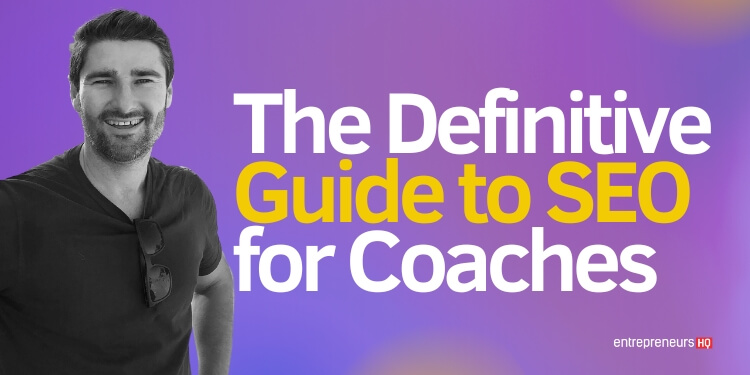
With so many online coaches available, it is critical to cut through the noise to get your offer in front of the right people.
And that’s what SEO for coaches can help you to accomplish.
In this guide, I’m sharing the proven strategies and tactics you need to know to succeed with SEO in 2024.
Table of Contents
SEO Basics for Coaches
SEO stands for Search Engine Optimization.
It is the process of enhancing your site’s search engine rankings so you can get free, organic traffic from Google. This increase in traffic brings more people to your site and, as a result, your coaching services.
For this reason, it’s essential to have a fundamental understanding of the basics of SEO to thrive online as a coach.
Why is SEO Important for a Coaching Business?
SEO is the foundation for a flourishing online coaching business.
It can give you the freedom and flexibility to enjoy more of life. You won’t be restricted to a traditional office space to coach your clients, as you can become location-independent as an online coach. But that’s only the beginning…
Here are a few additional benefits of SEO for coaches.
Reduced social media reliance
Many coaches rely too heavily on social media.
I’m not saying you shouldn’t use Instagram or Facebook – you should. However, the problem is that you don’t own those platforms or the audiences you build on them. If the Instagram “powers that be” decide they don’t like something you’ve posted, they can arbitrarily ban you from their platform.
However, if you’ve invested in a website domain and email list, all of which you own, you can avoid the dangers that come with relying too much on social media. And SEO, as well as social media can help you drive traffic to your owned channels.
Passive marketing
Once you’ve done your part, SEO does all the heavy lifting for you.
It runs on auto-pilot, showing your content and website to your target market while you go about business as usual. This is an under-discussed form of passive marketing. An effective SEO strategy can help you generate leads, build trust, and even make sales.
With the exception of a few periodic check-ins to ensure the “machine” is running optimally, it’s a hands-off marketing system.
Easily target your coaching niche
A critical aspect of the coaching industry is differentiation.
Are you a health coach, business coach, or relationship coach? You must identify your coaching niche to achieve online success in your business. SEO enables you to fine-tune and hone in on your target market more precisely than conventional marketing methods.
Now, here comes the good part…
All you need is a website
All you have to do is identify the keywords and key phrases your audience is searching for and create relevant, high-quality content that satisfies their needs.
All that’s required is a functional website with your own domain name. Once you have these two basics covered, it’s simply a matter of creating high-quality, SEO-optimized content for your target market.
You have more ready buyers
People go on search engines because they have a problem they want to solve.
They’re intentionally looking for a solution. You have a warm lead who’s ready, willing, and able to do business with you. For this reason, they’re far more likely to buy than someone scrolling social media while waiting in line for their morning coffee.
SEO helps to bridge the gap between buyer and seller quickly and easily.
Establishing A Solid Foundation: Technical SEO 101
The foundational piece of technical SEO is crawlability.
Search bots gather site information as they crawl your pages. These crawlers help Google properly index your site, giving it more visibility to people who are actively searching for your content.
This is the technical side of SEO.
What is technical SEO?
Technical SEO consists of more mechanical search engine optimization practices.
It involves processes to ensure websites meet search engine requirements for improved ranking performance. This process offers many advantages for coaches, such as more traffic, leads, and sales. Moreover, there are four elements associated with technical SEO.
These four elements include the following:
- Crawlability: In an SEO context, crawlability refers to the web crawlers (or search bots) that discover your website and its content. These bots scan your site’s articles, web copy, videos, images, and more to understand your site and index it appropriately.
- Indexability: Indexability enables search engines to rank your site on the proper SERPs (Search Engine Results Pages), so your target market finds you with their search query. Content that is not indexed has no chance of ranking on search engines, so indexability is essential for SEO for coaches.
- Accessibility: Accessibility is all about making it easy for visitors to access and navigate your website. Google values the user experience. Sites that offer a negative user experience through poor navigation, slow site speed, unresponsiveness, or bad design layout don’t engage or retain users for long. And that’s not good for SEO.
- Rankability: Rankability simply means a site (or its content) holds high SEO ranking potential. So, what contributes to a site’s rankability? Pretty much everything we’ve discussed so far: High-quality SEO-optimized content, proper keyword research, backlinks, optimized metadata, a positive user experience, and more all contribute to a website’s rankability.
Together, these SEO essentials create a fully optimized site combined with a positive user experience. As a result, your target market will return to your site over and over, which further improves your SEO rankings.
SSL and HTTPS
SSL and HTTPS are important SEO ranking factors.
SSL (Secure Sockets Layer) is an encryption-based site security agreement. And it’s essential for your site’s security, credibility, and, yes, even SEO. In fact, I would go as far as to say it’s as important as site functionality. It’s a signal to visitors that your site is safe and verified. It also improves your SEO performance, as it’s an indicator of trustworthiness.
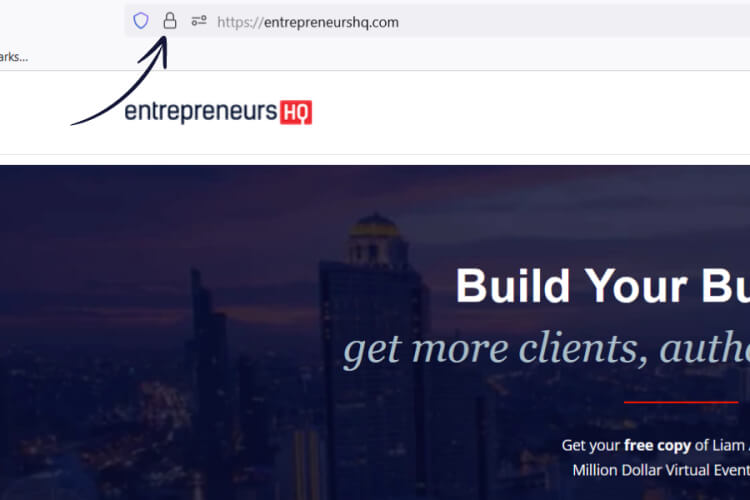
Getting an SSL set up is simple. And the best part is that you have a few options. Here is how you can get an SSL certificate for your site:
- Through your hosting company. Hosting companies generally offer free SSL certificates. For the higher-priced plans, the SSL will usually be added automatically. However, you may find that on some of the basic options plans, you’ll have to activate the SSL certificate yourself. To do this, simply visit the panels of your hosting company and add the SSL to your domain. Some popular hosting companies that offer free, pre-installed SSL certificates include Bluehost, HostGator, and Hostinger.
- Add it manually. It’s always better if your SSL is added for you. However, you can always do it manually if you’re with a hosting company that doesn’t offer it pre-installed, and you don’t want to go through the hassle of switching hosting companies. One of the most well-known organizations that provides SSL is Let’s Encrypt. Their website offers step-by-step instructions on how to get a free SSL certificate.
Conversely, HTTPS (Hypertext Transfer Protocol Secure) is simply an encrypted and verified extension of HTTP. It signifies a secure virtual network and is critical for SEO as it authenticates your web server.
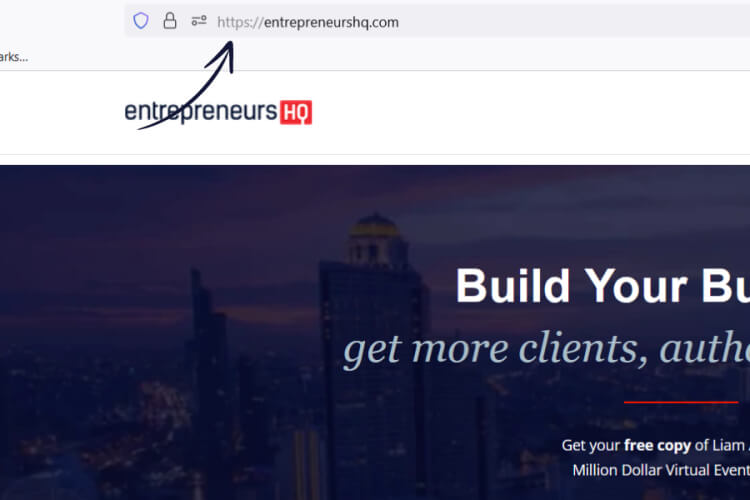
Using HTTPS with your domain name requires an SSL certificate on your website. An HTTPS website ciphers the virtual communication that occurs between your web server and the browser. As a result of this encryption, your content is made confidential and protected as it crosses back and forth between the browser and the server.
Site speed
Site speed matters with SEO – a lot.
In fact, it’s a contributing factor to your overall SEO performance. An adequate site speed load time is three seconds. An exceptional site speed load time is one to two seconds. In short, the faster your site loads, the better.
Google is more generous when it comes to ranking toward fast-loading sites compared to slower ones.
Again, this comes down to user experience. A site that is slow and sluggish, taking a dozen seconds or longer to load, will cause people to become impatient and bounce. Most people aren’t going to stick around for a site to load when they can get the information they want from faster alternatives.
Here are a few steps you can take to accelerate your site speed:
- Remove unnecessary plugins. Plugs are commonplace in pretty much every site. And for good reason. They provide many useful features that can help streamline your coaching business. However, they can also slow down your site if you have too many of them active at once. So, deactivate or remove any plugins you don’t use.
- Use a CDN. A CDN (Content Delivery Network) is designed to help any long-distance visitors receive your website’s content much quicker. This process improves the user experience, lowers bounce rates, and increases online traffic.
- Use a Cache. Web caching is critical for improving your site speed. Cache memory reduces the time required for your processor to access web data, resulting in a faster and more efficient website processing speed.
Core web vitals
When it comes to SEO for coaches, understanding Core Web Vitals is essential.
CWV represents the fundamental elements of the user experience. For this reason, it’s important to incorporate them into your SEO strategy. Core Web Vitals are standardized metrics that measure the user experience regarding three critical Google ranking factors.
- Loading performance. This metric represents how quickly a site can load all of its pages to be fully functional for the user. It’s measured through Largest Contentful Paint (LCP) to provide a positive user experience for site visitors.
- Interactivity. Interactivity is all about your site’s responsiveness. With users expecting more online businesses regarding site performance, Interactivity helps to bridge that gap to create a seamless experience. This metric is tracked by Core Web Vital’s Interaction to Next Paint (INP), which analyzes your site’s responsiveness.
- Visual page stability. Visual stability represents the level of stability your page has while loading. It’s measured by Core Web Vitals’ Cumulative Layout Shift (CLS). Elements that move or shift on your page as it loads contribute to a higher CLS. The idea is to have all the components on your site set up in a coherent manner, working harmoniously together to create a fresh, solid, and cohesive website experience.
Helpful list of free technical SEO tools
For many coaches, SEO can feel confusing and overwhelming.
And that’s understandable, considering your knowledge base is geared toward human development rather than the technical aspects of digital marketing. However, even a baseline understanding of SEO can be tremendously useful in your coaching business.
Luckily, there are many free tools at your disposal that can simplify and accelerate the learning curve, including:
- AnswerThePublic: AnswerThePublic is a free audience research tool that helps you discover certain questions people are asking on Google regarding various topics. It scours through Google to provide a myriad of questions on your particular subject. Moreover, it includes other important metrics, like competition info and search volume.
- Rank Math SEO WordPress plug-in: As a WordPress plug-in, Rank Math SEO is a useful, free tool that improves your site’s SEO performance on Google. It provides you with easy suggestions that can improve your content’s readability and SEO standing.
- Google Analytics: Google Analytics is a platform that offers a “one-stop-shop” for your analytics and advertising. As a result, you can gain important client insights quicker so you can market your coaching services better. And the best part? There is a free version of this software you can use to get started.
- Google Search Console: Google Search Console helps you to track and troubleshoot your site to improve its search engine presence on results pages. It’s a free service that helps you gain a better understanding of how Google indexes sites and what you can do to improve your current ranking.
- Google Keyword Planner: Google’s Keyword Planner tool helps you to do proper keyword research to improve the results of your search campaigns. This free tool can help you uncover new keywords related to your coaching business so you can more accurately target your ideal clientele.
Technical SEO checklist
Once you’ve developed a basic understanding of SEO, you may ask, where do I begin?
Doing things out of order can result in you backtracking instead of moving forward in your digital marketing efforts. For this reason, I’m going to provide you with a simple, step-by-step checklist.
Here is the technical SEO checklist that every coach should know.
- Do proper keyword research. Without knowing the right terms and phrases your audience is actively querying on search engines, you’ll have no clue what you should be basing your content around. So, ensure you’re doing your keyword research properly.
- Use SEO tools. Use the free SEO tools (as listed earlier in this post) to supplement your content creation process. This will streamline things while accelerating your efforts.
- Avoid bad SEO tactics. A big part of SEO success is simply knowing what not to do. So, ensure that you avoid bad SEO tactics such as keyword stuffing, duplicate content, or paying for shady links. This alone will put you in good standing with search engines.
- Optimize your site and content. Ensure that your titles, URLs, images, and metadata are fully optimized with your primary keywords. You should also include internal and external links within your content, fix broken links, and ensure your site is mobile-friendly. These are the foundational pieces of having an optimized site.
There’s a lot more we could cover with SEO best practices. However, it’s always wise to keep things simple when getting started. So, before you try searching for all the exotic, “never-before-seen” SEO tactics, ensure that you’re first covering the basics.
Content Optimization 101: Creating Content That Ranks
Content optimization requires more than posting a few articles on your blog.
Fortunately, you don’t have to reinvent the wheel, as a proven roadmap is already available to you. Here are some SEO best practices you can implement to create content that ranks.
What is keyword research?
Keyword research is the process of identifying words, phrases, questions, and terminology your target market is typing into Google. This process requires careful study to determine what your market is struggling with. The good news is that keyword research helps you position your products and coaching services as solutions to your prospect’s needs.
Techniques for effective keyword research
Like anything, effective keyword research comes down to strategy.
With the right strategy, you can accelerate and skyrocket your success. With the wrong strategy, you’ll waste valuable time and energy chasing a goal post that you’ll never reach. For this reason, you want to optimize your efforts with a proven blueprint that will get you results.
Here is your keyword research blueprint.
Create a list
Make a list of all the possible words, phrases, and questions your market may be struggling with.
An excellent SEO tool to help with this process is Keywords Everywhere. This tool provides you with a clear overview of your audience’s search intent. Below is an example of Keywords Everywhere in action.

Once installed, Keywords Everywhere provides you with a host of possible keyword phrases your audience is searching for. It gives you access to the monthly volume of the keyword, its level of competitiveness, and even its cost per click. As a result, you can create an extensive list of targeted keywords your audience is genuinely searching for.
While Keywords Everywhere does offer a free version, the paid version is only about ten dollars, and it’s worth every penny.
Use search engine suggestions
Search engines have made things easy for you. Let’s say, for example, you’re a health coach who helps busy executives balance healthy eating with a demanding schedule. You can go to Google or YouTube and type in longtail keyword phrases such as “healthy eating busy lifestyle,” like in the example below.
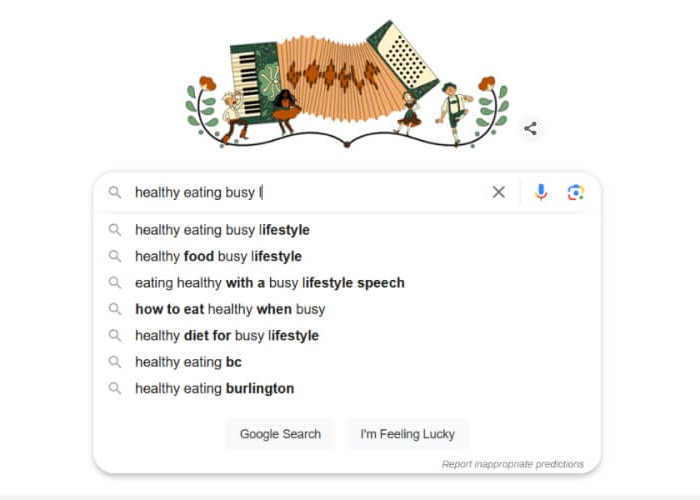
As you begin typing, the search engine automatically attempts to complete your query. It uses data based on previous search queries to present you with the latest and most accurate information related to your search.
This is an invaluable (and free) technique for determining what your audience is searching for.
Analyzing competitor keywords
As a coach and business owner, you need to know your competitors.
You need to know their angles, keyword phrases, and positioning within your niche. This knowledge can help you determine your position in relation to them. Moreover, it gives you insight into where they’re lagging and how you can gain a competitive edge.
So, take the following steps to analyze your competitor’s keywords.
Search your target keywords
Go to Google or YouTube and type in the keywords you’re attempting to rank for. The businesses that occupy the first pages of the search engines are your competitors. For instance, if you’re a sales coach, you’d type “Sales coaches [your area]” into Google.

The image above shows the coaches who are ranking for your competing keywords. This process gives you perspective on who your competitors are and what they’re doing to rank on search engines.
Evaluate the ranking difficulty of keywords
There are many variables that contribute to your ability to rank on a particular keyword.
Some of these factors – like quality content – are within your control. However, other factors – like how long your competitors have been in business relative to you – are out of your control. For this reason, it’s important to know that you won’t be able to rank for some keywords that your competitors already have a stronghold on.
To determine whether or not you have a chance, you need to evaluate the difficulty of each keyword.
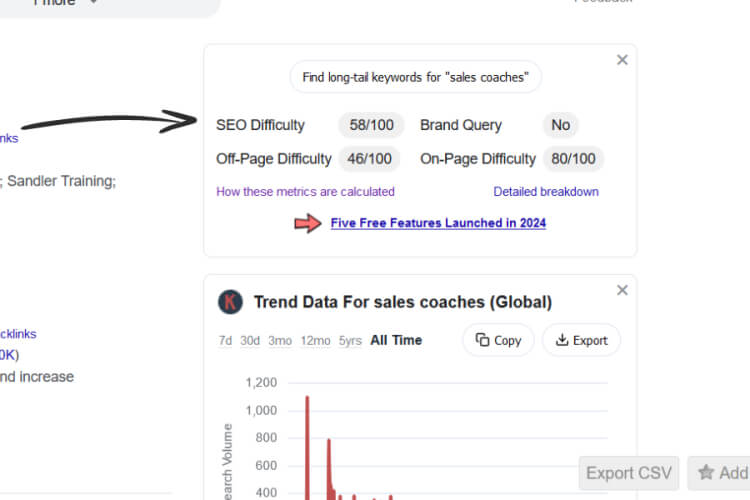
The image above shows an SEO Difficulty of 58/100. This score would be a long shot, especially if you’re just starting out in your coaching business. A good score to shoot for is between 30 to 45. This score is the sweet spot. Its difficulty level communicates that people are actually searching for it without it being overly competitive.
Essential elements of on-page SEO
SEO for coaches begins with on-page elements.
Google scans and crawls your pages, looking for these elements so it can index your site appropriately. As a result, these components must be accounted for if you want to see success with your SEO strategy.
Here are some of the essential on-page SEO elements you need to know.
- Quality content: Does your content genuinely help people? Is the text broken up with headings and subheadings to make it easy for readers to consume? Have you written it with proper grammar and punctuation, offering actionable tips and step-by-step processes to help your audience? Remember, Google values the user experience. Your content must be exceptional and offer genuine value to readers.
- Metadata: Metadata (also known as microcopy) is the text that communicates what your page or content is about to search engines. It includes your URLs, meta title, meta description, and more. Metadata helps search engines optimize and index your site and content so your target market can find you with their search queries.
- Images: Images help break up text, making your content more inviting and digestible. Moreover, they also increase SEO value by boosting engagement in articles and web copy.
How to build a content strategy
Your content strategy is your roadmap.
It guides your decisions around content creation through a structured framework. As a result, you can produce content that’s helpful, valuable, and aligned with your target market’s needs and wants.
Here are a few proven steps for creating an effective content strategy.
- Determine your goals. Every content strategy should be focused on a particular outcome. What’s yours? Do you want to drive more traffic to your site? Build an audience for your brand. Get prospects to opt into your high-ticket sales funnel. With your goal in mind, you can begin creating the strategy that will get you there.
- Study your target market. You should know your audience better than they know themselves. Get clear on their wants, desires, frustrations, pain points, where they live, what they do, their age, and marital status. All of these details will give you a broader perspective on who your people are and what you need to do to attract them to your offer.
- Decide on deliverables. This step involves determining the type of content you’ll deliver. Will you film videos, publish blog posts, record podcasts, host virtual summits, or write emails? There are many options to choose from, and you may have to experiment to find what works best for you and your audience.
- Map out your schedule. Creating high-quality content takes time. For this reason, you have to accommodate this process in your schedule. For example, you could spend every Sunday afternoon shooting YouTube videos or writing new articles. Whatever works best for you, ensure that you make it a regular part of your business operations.
- Create your process. There’s always a method to the madness. A process you follow for your content creation simplifies things. It accelerates this activity, making it more efficient in other aspects of your business.
- Track your results. You can’t improve what you don’t measure. That’s why you should monitor your content’s performance. This process enables you to see what you’re doing well and what needs to be improved. Install Google Analytics to track your performance metrics. You should perform content audits at least every six months.
Article optimization best practices
It’s easy to get sucked into the article optimization rabbit hole.
When learning these SEO tactics and techniques, coaches tend to put all their efforts into pleasing the algorithms instead of the reader. But the truth is that search engines value content that is reader-focused. So, creating genuinely helpful content that satisfies the reader – while supplementing your efforts with SEO – is the recipe for success online.
Consequently, one of the best practices for article optimization is writing valuable, high-quality content that helps real people.
Here are some of the article optimization best practices you should adhere to:
- Optimize the URL with the primary keyword
- Optimize metadata (SEO title and meta description) with keywords
- Optimize headings and subheadings with primary and secondary keywords
- Add internal and external links
- Break up the text with headings, bullet points, and numbered lists
- Optimize images for SEO using the alt text field
Helpful list of free and paid on-page SEO and keyword research tools
While I advise you try the free on-page SEO and keyword research tools first, you should also familiarize yourself with some of the paid options as well.
The free tools help you to get your feet wet, providing you with a basic understanding of SEO. However, the paid tools will help you take things to the next level. Here is a list of both paid and free SEO tools for your online coaching business.
- Moz keyword explorer (free): Moz keyword explorer helps you locate and sort through words and terminology people query in search engines. It uses metrics like relevance, competitiveness, and monthly search volume to determine the likelihood of rankability.
- Google Keyword Planner (free): Keyword Planner facilitates the keyword research process. This tool is free, and it helps you uncover new keywords that you may want to rank for in your coaching business.
- Google Trends (free): A free Google SEO tool, Google Trends allows you to research and dissect search queries that are typed into Google Search over a range of regions. You can analyze different geographical locations and the associated keyword popularity of each area to determine keyword rankability in each area.
- Google Analytics (free with a paid version): Google Analytics is a popular paid SEO tool that monitors how frequently certain actions are taken on your website. These actions can include filling out forms, spending time on certain pages, and more.
- Keyword surfer (free): Keyword surfer is a very useful tool that lets you see search volume in search results of Google. As a result, you can learn valuable insights on KPIs such as keyword performance, CPC, search volume, and even metrics for visibility and on-page activity.
- Ahrefs (paid): Ahrefs is one of the most powerful and popular SEO tools available. It’s a one-stop-shop platform that can help you optimize your site and content.
- SEO Powersuite Pro (paid): SEO Powersuite Pro comes equipped with numerous tools that can supplement any SEO campaign. It includes an SEO analysis tool for performing in-depth keyword research, finding backlinks, optimizing content, and more.
Local SEO 101: How To Attract Local Clients
Building your brand as a coach begins locally.
Chances are, many competing coaches in your local area are not consuming an in-depth guide like this. As a result, you have a competitive advantage when it comes to local SEO if you apply what you learn here.
What is local SEO?
Local SEO is the process that helps your business gain more visibility in the virtual world with Google search results in your local area. If your coaching practice serves your local area out of a brick-and-mortar office, you can benefit from local SEO.
For example, if you were to type “life coaching Los Angeles” into Google, you’d get the following results.
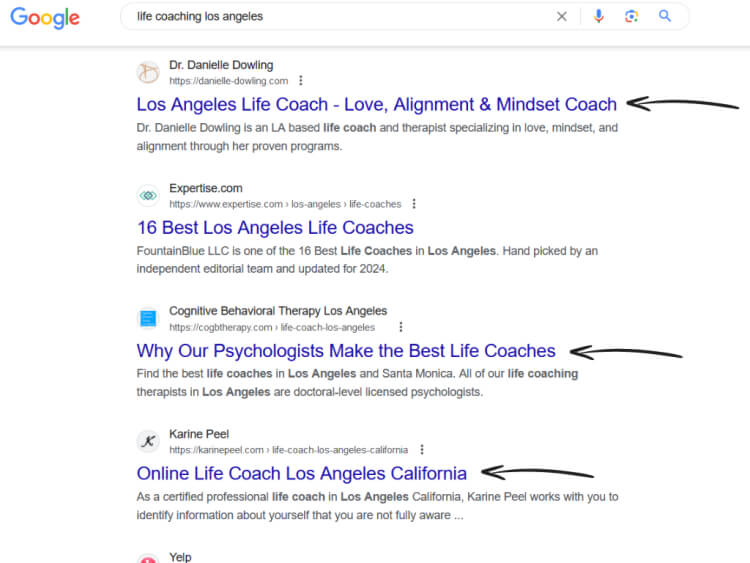
You will receive search results showing various life coaches in the Los Angeles area. These life coaches have done an excellent job using local SEO to make their businesses visible in search engines. As a result, they get traffic to their sites on auto-pilot to grow and expand their businesses.
But now, you may wonder how you can use Local SEO for your coaching practice. The answer is simple: You have to take the next step, which is to learn about Google My Business.
How to set up your Google My Business
Google My Business enables you to generate more visibility for your business’s website.
Once you create a profile, you can contact clients and track how prospects use Google to connect with your business. This can give you better rankings, increase trust with your clientele, and provide valuable data to improve your SEO performance.
Here’s how to set up Google My Business. First, you need to sign into your Google account.
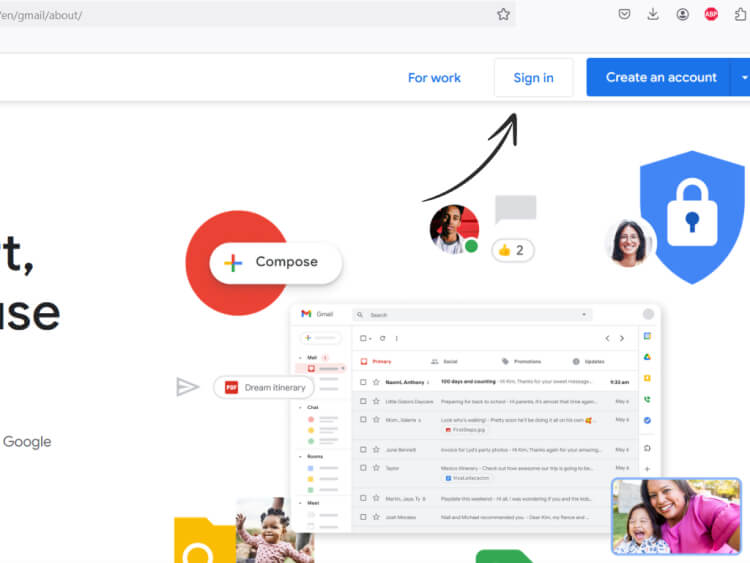
Next, you click the dotted icon in the top right corner, which will reveal a drop-down menu of Google services. Click the “Business Profile Manager” icon.
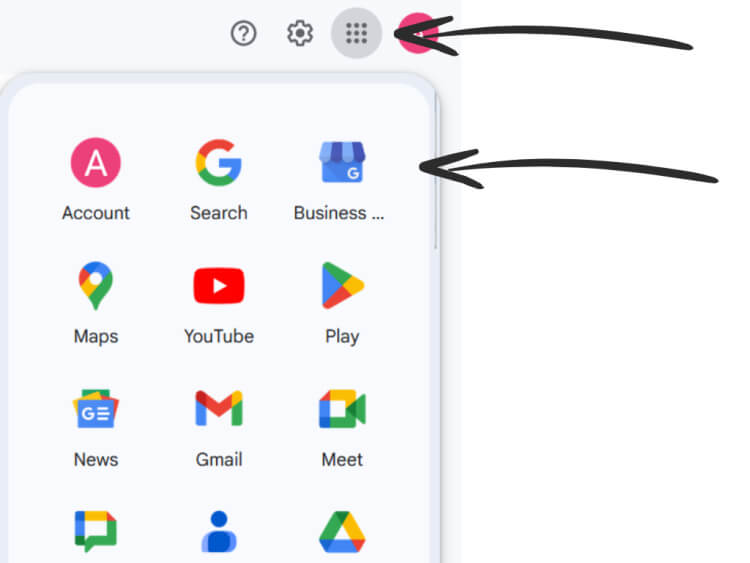
You’ll then be brought to the page where you can add and optimize your business information on Google.

You can add photos and images, ask clients to write reviews, and include your contact information.
Why GMB is important for coaches?
GMB is an essential aspect of your online coaching business.
It’s a practical tool that’s easy to manage, offers premium services, and doesn’t cost you a penny. What’s more, it’s a form of advertising that can attract many prospective clients both locally and internationally.
Jacqueline Hurst is a life coach from London, and she is an excellent example.

Her GMB profile displays all the critical components that add to her credibility and build trust with her prospects. It includes 109 five-star reviews, her website, and her phone number for easy contact, as well as her services, letting prospects know what she offers.
GMB optimization tips for coaches
Once you have your GMB profile set up, it’s now time to optimize it.
This simple process will create more visibility and trust in your market.
The first step is to add photos. Images help to “humanize” your business. It fosters a sense of connectivity when prospects can see you and your employees working as a singular unit.
To add photos, simply go to your Google Profile Manager and click on the “photos” icon.
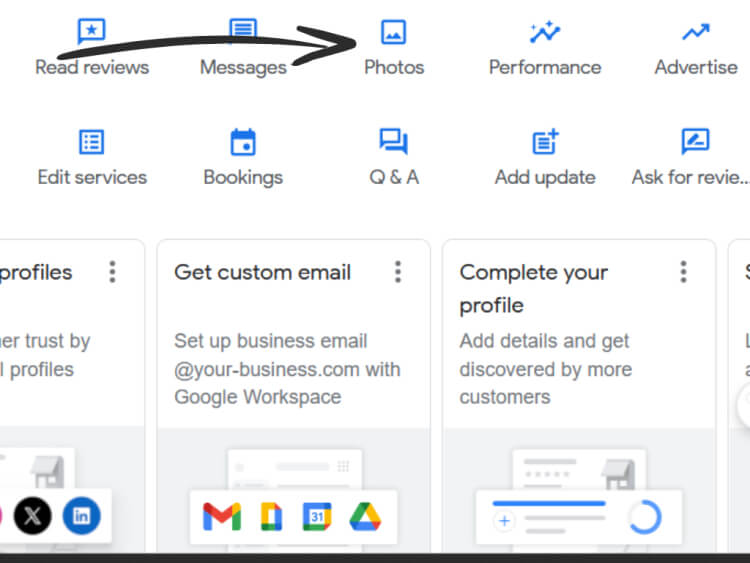
It will bring up an “add a cover” and “add a logo” section. Add both.
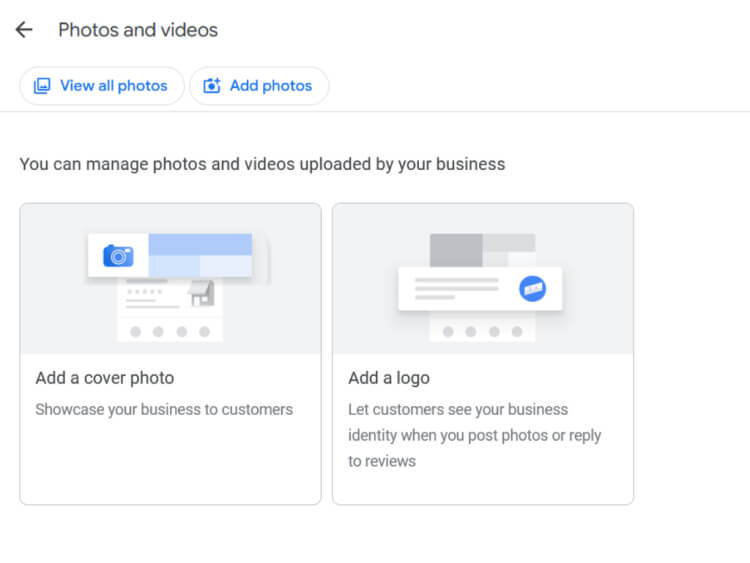
The next step in optimizing your GMB profile is to use keywords. You should always keep your keywords at the top of your mind, as these are the phrases and queries your audience is typing into search engines.
A good example of this is with a San Diego-based business coaching company called Infuse System. They naturally use their keywords throughout their GMB description.
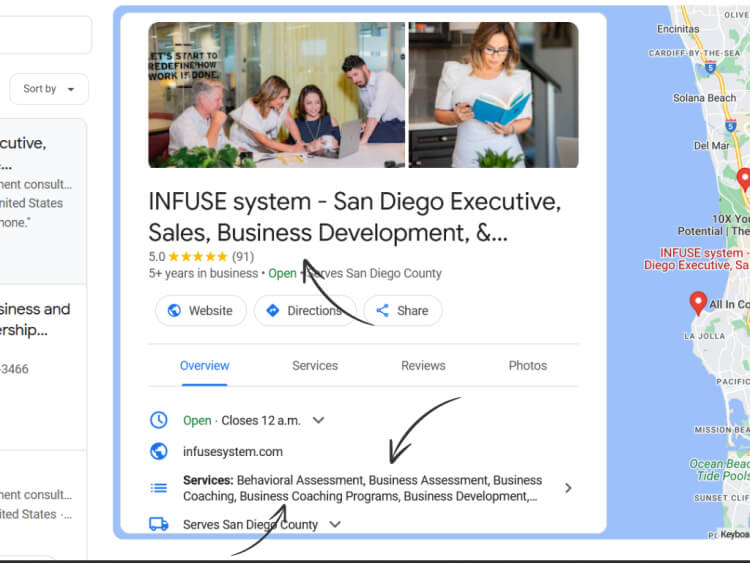
Next, ensure that you monitor and stay up to date on your reviews. Any negative testimonials can impact how prospects view your coaching business, so it’s essential to keep tabs on this aspect of your business.
How to find and target the right local keywords
The first step to finding the right local keywords begins with determining your core term.
Your core term is simply what your business does. As a coach, your business is coaching. Therefore, your core term would be “coach or coaching services.” You could also include your niche. For example, you could use “health coach, life coach, or fitness coach” for your core term.
Here’s an example of what that looks like with a Google search result.

Next, try adding keyword modifiers. A modifier adds specificity to your search, narrowing the intent to a more focused service. For example, “sales coaching” becomes the keyword modifier in the image below.

Lastly, use your location in your headings. This will further optimize your business’s online presence and make it relevant to people searching for it in your area. In the example below, the addition of the Houston location creates a more focused search for coaches in that area.
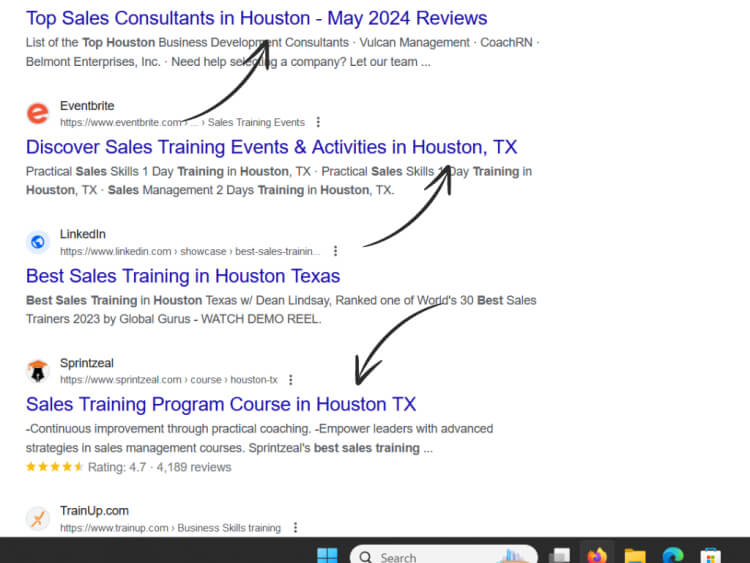
Helpful list of free and paid local SEO tools
There are numerous SEO tools (free and paid) that can help you find local keywords.
Each offers different features and capabilities, so you’ll want to do your due diligence when selecting one for your coaching business. Some perform in-depth audits to find SEO issues, while others reveal valuable website ranking insights.
- BrightLocal. Brightlocal is an SEO tool that offers many tools to help with local SEO marketing. Some of its features include reputation management, local SEO and rank monitoring, customer review tracking, and more. It offers free and paid versions.
- Ubersuggest. Ubersuggest stands as one of the most intuitive and user-friendly SEO tools. And the best part? It’s free. It’s an all-in-one SEO tool with advanced software that offers many robust capabilities to help your coaching business stand out online.
- Synup. Synup is a local SEO tool customized to help supplement your online marketing campaign. It enables you to track analytics, create detailed reports, and manage various lists in your business. Synup is an affordable SEO tool that’s more than worth the price.
- Screaming Frog: Screaming Frog is a free website auditing tool that shows you your site’s key optimization elements. Similar to search engine spiders, it crawls your website to reveal any technical SEO problems, such as missing alt tags or broken links.
- Georanker: Georanker is one of the most effective SEO tools available. It allows you to see where you stand in relation to your local competitors, providing valuable insights into how you can gain a virtual advantage. Georanker is a paid SEO service.
Backlink Building 101: How To Boost Your Site’s Authority
One of the most effective and powerful ways to boost your site’s authority is with backlinks.
This is a strategic SEO practice that many coaches, to their detriment, often overlook. For this reason, it’s essential to accumulate backlinks to your site. This section will detail proven tactics you can use to build your reserves of backlinks.
What are backlinks?
A backlink is a link from one site that links out to another.
High-quality backlinks are critical for SEO, as they can increase your search engine ranking and improve your online visibility. As a result, you can generate more traffic to your website with enough high-quality backlinks connecting to your domain.
Here’s the thing: the entire web is connected by links.
So, the more links you have pointing back to you, the more Google sees you as an authority within your space, which leads to higher search rankings and a stronger domain authority.
What is domain authority?
Your domain authority (DA) is your search engine ranking score.
It was created by Moz (a popular SEO company that helps people and businesses conduct SEO campaigns). Moz developed the concept of domain authority to predict the likelihood of a website ranking on search engines. The DA score ranges from 1 to 100.
For example, Robin Sharma is a leadership coach whose official website has a DA of 54/100.

Domain authority falls in step with domain rating (DR). The difference, however, is that domain authority represents a website’s search engine ranking potential, while domain rating represents a website’s backlink quality.
Why are backlinks important to ranking on Google
Backlinks are the links that lead from other websites to your website.
These links act as votes of confidence. Google recognizes backlinks as a form of trust or faith that other sites have in your brand. As a result, they play a crucial role in helping Google see your site and coaching business as authoritative figures online.
Since Google is interested in quality, it’s always trying to promote industry experts to the top of SERPs (Search Engine Results Pages).
Best practices for acquiring high-quality backlinks
One tactic for acquiring backlinks is guest posting.
You can write a couple of guest articles for other coaches or companies within your niche for free. This is a win-win situation. They get a free, high-quality article, and you get a free backlink to your site in the author bio section of the post you created.
Greg Walthour is an excellent example.
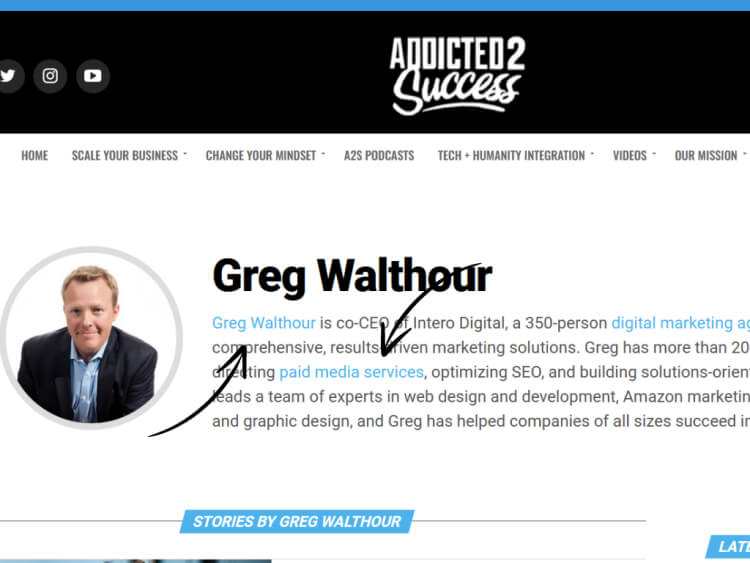
As the CEO of Intero Digital, Greg is a consultant and entrepreneur. He wrote a guest post on Addicted2Success.com (a personal development website) with numerous backlinks to his social media handles and website.
Next, you can write ultimate guides to garner more backlinks.
Ultimate guides serve as a “one-stop-shop” post for people to get all the information they need on a particular topic. As a result, they are often in-depth, well-researched articles that solve a pressing problem for readers. This means “ultimate guides” are valuable posts with a lot of backlink potential.
Backlinko is a great example of this concept.
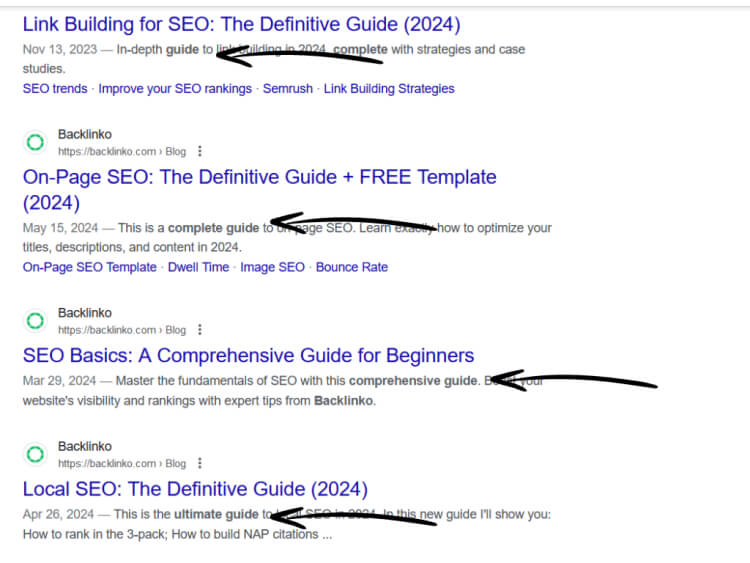
He has numerous ultimate guides offering in-depth, long-form content that gamers backlinks. As a result, Brian Dean (the owner and founder of Backlinko) is one of the leading experts in SEO marketing.
Common SEO Mistakes And How To Avoid Them
Knowing what to do in your SEO strategy is only half the battle.
The other half of the battle is knowing what not to do. You can have the best SEO tactics in the world, but if you aren’t familiar with the mistakes to avoid, you can easily neutralize all the best practices you implement in your SEO strategy.
So, here are the common SEO mistakes you need to avoid.
Not doing proper keyword research
Nothing else matters if you’re not doing keyword research.
All of your SEO efforts are based on what your potential coaching clients are typing into search engines. You can get everything else right with SEO, but if your prospects can’t find you because your site isn’t optimized with the proper keywords, then your competition will get the coaching clients that should have been yours.
Publishing low-quality content
Remember, your content is supposed to help your audience solve their problems.
It should be skimmable, insightful, easily digestible, and full of helpful tips and suggestions. If it doesn’t meet these criteria, people won’t consume what you’re publishing. As a result, your bounce rates will increase, and Google will see this as a signal that your site is not helpful to the people who are finding it.
Whether it’s content on a blog or copywriting on a sales page, your copy must be written with proper grammar, punctuation, and keywords for it to perform.
Ignoring mobile optimization
Most people today are now using their smartphones to access information.
That means if you’re not optimizing your website for mobile, you could compromise your SEO performance. Your site should have a quick load time on mobile devices. Moreover, your site’s layout should be adjusted by cropping to people’s smartphone screens to create a positive user experience. All of these create better engagement with your site while people are on the go.
The result? Google will recognize the reduction in bounce rates and reward you with improved rankings in its SERPs.
Unoptimized metadata
All the metadata on your site should be fully optimized with the appropriate keywords.
These metadata touchpoints include your URLs, alt texts for images, SEO titles for articles, and meta descriptions for your site and blog articles. Metadata helps Google better understand what your site is about so it can better rank it for the appropriate keywords.
Ignoring backlinks
Backlinks build your authority with Google.
For this reason, ignoring them is one of the worst things you can do for your SEO performance. Sites with no backlinks leading to their pages or content suffer in results pages. Don’t let that be you. As a coach, it’s essential to build your backlinks for search engines to recognize your authority online.
You can build your backlinks by producing in-depth, high-quality content or even guest posting on other sites in your industry.
Leaving broken links
Leaving broken links on your site might seem innocent.
However, Google penalizes sites with too many broken links for a reason. When a reader sees an engaging anchor text leading to another page only to hit a wall with that obnoxious “404 error page,” it compromises the user’s experience. Therefore, Google sees this as an SEO best practice violation.
To avoid this, ensure all your links lead to helpful, high-quality pages, whether it’s within your own site or an external site.
Not using analytics tools
Analytics tools are critical for coaches’ SEO success.
They give an in-depth, inside look at how your content and website are performing. Moreover, they also share who’s coming to your site, where they’re coming from, the actions they’re taking once they arrive, how long they’re sticking around before bouncing, and much more.
These insights are invaluable.
You can use them to improve your optimization efforts, keyword targeting, and your overall SEO campaign. Here are a few high-quality SEO tools you may find useful:
- Ahrefs
- Semrush
- Google search console
- SurferSEO
- Moz Pro
- RankIQ
- Majestic SEO tools
Generic anchor texts
Generic anchor texts are vague CTAs that don’t do much to persuade the reader.
Some of these types of anchor texts include “click here, learn more, or watch this.” The action is obvious. However, the benefit to the reader is not. Descriptive anchor texts are always the better option if you’re going to link out from a page or article.
They add context and relevance to the reader (and Google), making them more effective when it comes to people actually clicking through.
A couple of examples of descriptive anchor texts include “get your 50% discount now, get your free coaching session today, or book a discovery now.” These texts are more benefit-driven and detailed in their presentation, making them more persuasive.
Keyword stuffing
Keyword stuffing was actually an effective SEO strategy in the early to mid-2000s.
However, Google has evolved and is now more sophisticated than ever. For this reason, keyword stuffing has severe consequences. Some of these can include a hit to your site’s credibility, poor user experience, and other penalties. Moreover, keyword stuffing is seen as an unethical SEO practice today.
What’s the lesson here? Just don’t do it.
Ignoring user experience
Many coaches fall into this trap.
They put all their efforts into trying to please the algorithms at the cost of the user experience. But what they don’t realize is that the algorithms value the user experience. The fewer people enjoying your site and its content, the more your ranking potential dwindles.
So, ensure that your site is optimized for search engines AND people.
After all, the algorithms aren’t reading your content, purchasing your coaching services, and keeping you in business. It’s people who are doing that. For this reason, you’ll want to ensure your site provides the best experience possible for your visitors.
Advanced SEO Techniques To Help You Rank Better
Your SEO strategy will grow and expand alongside your coaching business, so it’s helpful to have more in-depth tools and tactics at your disposal. However, an important caveat here is to ensure you cover the fundamentals first before moving on to these suggestions.
Here are some advanced SEO techniques to improve your search engine rankings.
Structured data and schema markup
Schema markup is code in structured data form.
It communicates your page’s content to search crawlers. You add this code to your page’s HTML. It distills the various elements on your site into a coded language that search engines can recognize, improving your click-through rate, organic traffic volume, and search engine rankings.
Voice search optimization
Voice search optimization helps you to appear in voice search results.
This SEO optimization tactic is useful because of the differences between text-based and voice-based queries. Voice searches usually have small differences in the way users ask questions.
Let’s look at an example.
If you want to hire a copywriter to write a sales page selling your coaching program, you’ll probably type “copywriting for coaches near me” into Google. However, you’ll most likely phrase a voice search query this way: “Hey, Alexa, can you find a copywriter who writes for coaches near me?”
You communicate to your voice assistant like it’s a real person.
As a result, voice search queries are longer-winded, more natural, and conversational, and they typically use complete sentences. So, they need to be optimized differently than text-based queries for better SEO results.
AI for SEO evergreen content optimization
AI is nothing more than a tool. And like the other tools mentioned in this guide, it can help streamline your processes, making things easier, faster, and more efficient.
This can be a game-changer for optimizing evergreen content.
Evergreen content will always remain relevant, but the optimization methods used on it will not always remain relevant. For this reason, it’s important to revisit old pieces of content periodically.
Here are some AI tools you can use for optimizing evergreen content.
- Clearscope
- SEO AI
- AlliAI
- NeuronWriter
- Pictory (for optimizing video content)
- Surfer SEO
- NeuralText
AI for technical SEO improvements
AI can also assist with the more technical aspects of SEO.
It can help you assess your site’s structure and performance, identify broken links, or fix any HTTPS or security errors. Many of the top coaches optimize their web presence from the top down. And AI can simplify and accelerate that process.
Here are a couple of tools that can help you with those technical improvements in your SEO strategy.
Key Takeaways
SEO for coaches is about the little things.
All these tiny optimizations you make lead to an optimally performing site that your coaching clients can easily find and navigate. If this feels overwhelming, we at Entrepreneurs HQ can help. We’ve been helping coaches grow their business for almost ten years.
So, if you need assistance, watch our free training on how to get coaching clients.